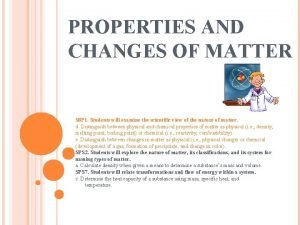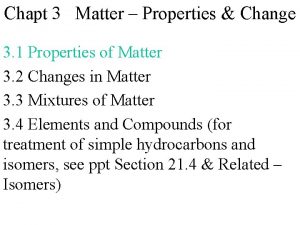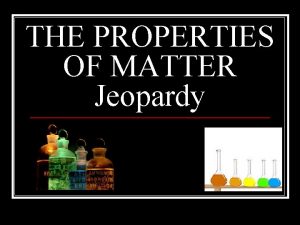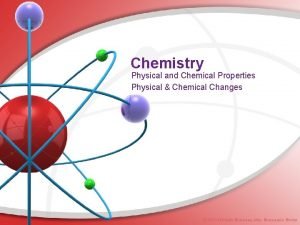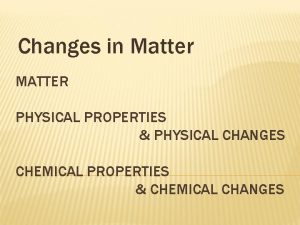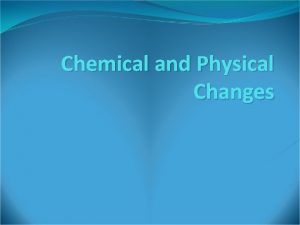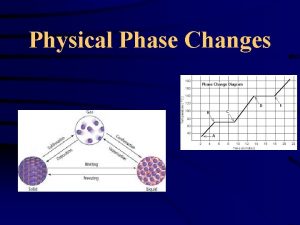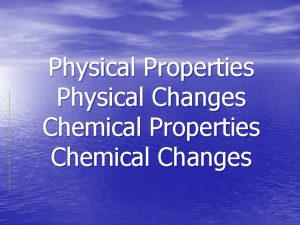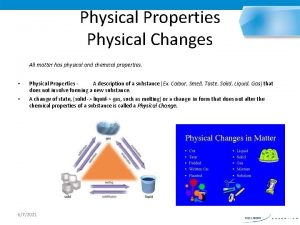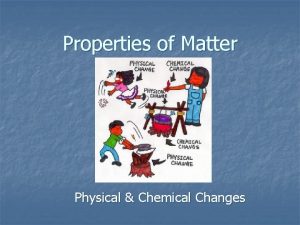Properties Changes of Matter Properties of Matter Physical











- Slides: 11

Properties & Changes of Matter

Properties of Matter � Physical Property- a property that can be observed and measured without changing the identity of the substance. � Examples? � Chemical Property-relates to a substance’s ability to undergo changes that transform it into different substances. � Examples?

Properties of Matter � Chemists use properties to identify and separate matter. More than one property must be used for identification. � Intensive Properties – do not depend on the amount of matter present Ex. Melting pt. , boiling pt, density, conduct electricity � Extensive Properties – depend on the amount of matter present Ex. Volume, mass

Changes in Matter �A physical change does not change the composition or identity of the substance. �Examples? �Boiled water is still water. �All phase changes are physical changes

Condense Freeze Evaporate Melt Solid Liquid Gas

Changes in Matter � Sublimation is a process in which a solid changes directly to a gas without going through the liquid phase. � Examples: dry ice CO 2

Changes in Matter �A chemical change occurs when one or more substances are changed into new substances. � Reactants- substances that react � Products- substances that form � Products have NEW PROPERTIES

Indications of chemical change 1 Production of heat, light, sound, or electricity 2. ) Production of a gas 3. ) Formation of a precipitate 4. ) A change in color 5. ) A change in odor

Energy Changes • Some changes in matter release energy. • For example, the explosion that occurs when hydrogen and oxygen react to form water is a release of energy. • Heat energy and light energy are released as the reaction takes place.

Energy Changes • A change in matter in which energy is absorbed from the surroundings is an endothermic process (heat enters). • EXAMPLES: melting ice & boiling water • When barium hydroxide reacts ammonium nitrate are mixed the test-tube feels cold to touch because energy has been absorbed

Energy Changes • A change in matter in which energy is released is an exothermic process (heat exits). • Examples: freezing water & condensation • Burning of paper gives off heat to the surroundings.
 Physical and chemical change
Physical and chemical change Physical and chemical properties
Physical and chemical properties Eating food physical or chemical change
Eating food physical or chemical change Properties and changes of matter worksheet
Properties and changes of matter worksheet Matter-properties and changes answer key
Matter-properties and changes answer key Properties of and changes in matter grade 5
Properties of and changes in matter grade 5 Physical/chemical changes & properties color by number
Physical/chemical changes & properties color by number Changes in latitudes, changes in attitudes meaning
Changes in latitudes, changes in attitudes meaning Physical properties of matter jeopardy
Physical properties of matter jeopardy Graphic organizer matter classifications
Graphic organizer matter classifications Physical properties of matter
Physical properties of matter Physical and chemical properties
Physical and chemical properties



